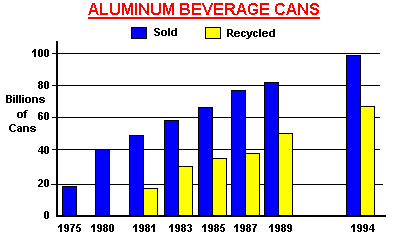
 | There are 29 cans per pound of aluminum, up from 22 in 1972. |
 | 99% of all beer cans and 97% of all soft drink cans are made of aluminum. |
 | The average aluminum can in the U.S. contains 40% post-consumer recycled aluminum. |
 | It requires only 5% as much energy when a can is made of recycled aluminum as compared to virgin ore! |
 | American consumers and industry throw away enough aluminum to rebuild the entire U.S. commercial air fleet every 3 months. |
 | In 1994, 3.1 million tons of aluminum waste was generated: aluminum containers and packaging, such as soft drink and beer cans, contributed 2.1 million tons. |
 | Aluminum made up 1.5% of the total municipal solid waste stream generated in the U.S. in 1994. |
 | Approximately 65.5% of aluminum containers were recycled in the U.S. in 1994. The overall rate for aluminum packaging was 55.0%. |
 | Most aluminum recovered from the waste stream is used to manufacture new cans. |
 | The lifespan of an aluminum can is 6 weeks on average: that means that the time it takes for a beverage can to be manufactured, filled, sold, recycled and remanufactured is 6 weeks on average. |
You might also like these convenient all-in-one battery recycling collection containers. There good for home or business. They're obvious and clear, no explanation required. It has everything you need, Everything you need to easily and safely recycle batteries:
an attractive box, instructions, a roll of tape, required labels, and a D.O.T. Special Permit.

 | A car battery contains 18 pounds of lead and one pound of sulfuric acid. |
 | Household batteries contribute many potentially hazardous compounds to the municipal solid waste stream, including zinc, lead, nickel, alkalines, manganese, cadmium, silver, and mercury. |
 | In 1989, 621.2 tons of household batteries were disposed of in the US, thats double the amount discarded in 1970. |
 | In 1986, 138,000 tons of lead-acid batteries were disposed of in the US. |
 | Regular flashlight batteries can be disposed of in the trash, though it is best to take them to a recycler. |
 | Mercury-oxide and silver-oxide button batteries are often collected by jewelers, pharmacies, and hearing-aid stores who sell them to companies that reclaim the metals. |
| In 1993, 80 to 95% of automobile batteries were recycled. |
 | Glass containers are 64% clear, 23% brown, and 13% green. |
 | 41 billion glass containers were produced in the U.S. in 1992. |
 | All glass food and beverage containers can be recycled. |
 | Recycling a glass jar saves enough energy to light a 100-watt light bulb for four hours. |
 | All newly purchased glass food jars contain at least 35% recycled glass. |
 | In 1994, approximately 13.3 million tons of glass waste was generated in the U.S. Food and beverage containers made up 91% of this amount: the remainder came from products like cookware and glassware, home furnishings, and plate glass. |
 | Glass constituted 6.3% of the U.S. municipal solid waste stream in 1994. |
 | About 25.8% of all glass food and beverage containers were recycled in 1994. Glass had an overall recovery rate of 23.4% that same year. |
 | Most of the glass recovered in the U.S. is used in new glass containers. A portion is also used in fiberglass and "glasphalt" for highway construction. |
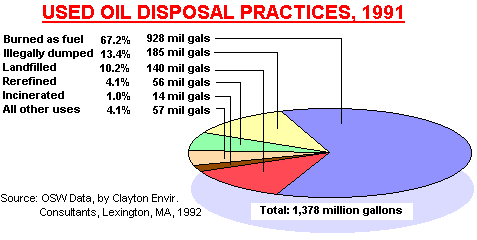
 | Since 1000 AD, world population has tripled, while fossil fuel use has grown tenfold. |
 | In 1989, almost 60% of the nation's automotive oil was changed by consumers themselves. |
 | Americans throw away enough used motor oil every year to fill 120 supertankers. |
 | Used oil from a single oil change (approx. one gallon) can ruin a million gallons of fresh water - a year's supply for 50 people. |
 | Used oil is insoluble, persistent, slow to degrade, sticks to everything from beach sand to bird feathers, and can contain toxic chemicals and heavy metals that pose a health threat to humans, plants, and animals. |
 | An estimated 200 million gallons of used motor oil is improperly disposed of each year in the U.S. by being dumped on the ground, tossed in the trash (ending up in landfills), and poured down storm sewers and drains. |
 | Recycling used oil would save the U.S. 1.3 million barrels of oil per day. |
 | The world's largest waste oil processing plant is located in East Chicago, Indiana. The facility is to recycle 75 million gallons per year of crankcase and industrial oil and 20 million gallons per year of oily wastewater. |
 | One gallon of used oil provides the same 2.5 quarts of high quality lubricating oil as 42 gallons of crude oil. |
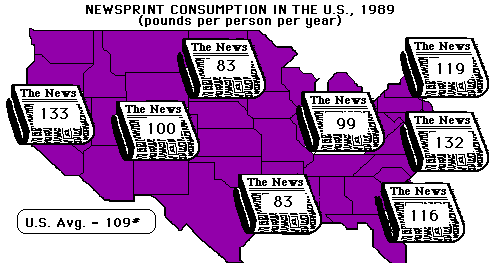
 | In one year, 2 billion books, 359 million magazines, and 24 billion newspapers are published in the United States. |
 | One year's worth of the New York Times newspaper weighs 520 pounds. |
 | In 1990, third class mail made up more than 2% of the waste disposed in the United States and weighed 3.6 million tons. |
 | Every ton of paper made from recycled materials saves about 17 trees. |
 | Every year, the U.S. and Canada chop down 34 million Christmas trees - enough to cover the state of Rhode Island with a forest. |
 | Recycling paper uses 60% less energy than manufacturing paper from virgin timber. |
 | The post-consumer recycling rate for old newsprint in the US in 1990, 1992, and 1994 was 38%, 47%, and 45% respectively (MSW Report). |
 | Nearly 81.3 million tons of paper and paperboard waste was generated in the U.S. in 1994. |
 | Paper and paperboard constituted the largest portion of the U.S. municipal solid waste stream in 1994, representing 38.9% of the total waste by weight. |
 | Paper had an overall recycling rate of 35.3% in 1994. About 55.3% of corrugated boxes, 45.3% of newspapers, 19.3% of books, 30% of magazines, and 42.5% of office papers were recycled in. |
 | Recovered paper is used to make a variety of products, including copier paper, paper towels and napkins, corrugated boxes, and hydraulic mulch. |

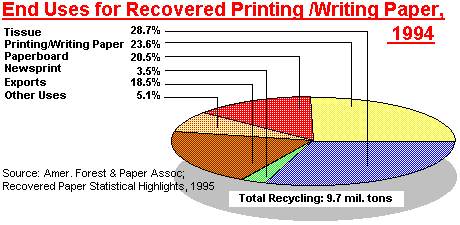
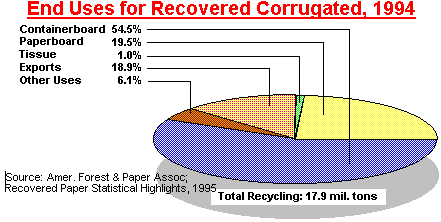

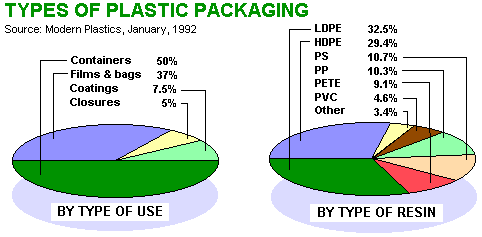
 | A one gallon plastic milk container that weighed 120 grams in 1960 now weighs just 65 grams. |
 | The average 1992 American car contains 300 pounds of plastic made from about 60 different resins. |
 | Every year, we make enough plastic film to shrink-wrap the state of Texas. |
 | 10% of the average grocery bill pays for packaging (mostly paper and plastics) - that's more than goes to the farmers. |
 | In 1993, plastics accounted for 11.5% of the U.S. municipal waste stream by weight (23.9% by volume). In 1994, plastics comprised 9.5% (by weight) of the waste stream. |
 | The rate of plastic soda bottle recycling rose from 33% in 1990 to 50% in 1994. |
 | 0.9 million tons of plastics (4.7%) were recycled in the U.S. in 1994. |
 | Products made from recovered plastic bottles include drainage pipes, toys, carpet, filler for pillows and sleeping bags, and cassette casings |
 | Every day, Americans use enough steel and tin cans to make a steel pipe running from Los Angeles to New York and back. |
 | 37 billion steel cans weighing 2,654,892 tons were used in the U.S. in 1991. |
 | 97% of all steel cans are used for food. |
 | The average American uses 142 steel cans per year. |
 | About 11.5 million tons of ferrous (e.g., steel and iron) waste was generated in the U.S. in 1994. |
 | Americans throw away enough iron and steel to continuously supply the nation's automakers. |
 | Ferrous metals constituted 5.5% of the 1994 U.S. municipal solid waste stream by weight. |
 | In 1994, approximately 53.1% of all steel cans and 27.8% of steel packaging materials, such as strapping, were recycled. The overall rate of ferrous metal recovery was about 25.2%. |
 | Steel food and beverage cans are recycled into a variety of products including new cans, bicycle frames, and even new cars. |
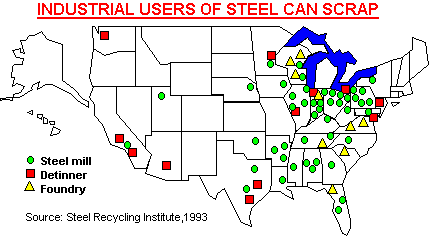
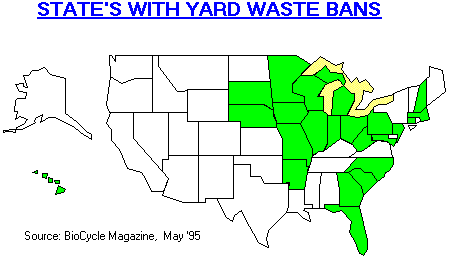
 | Leaves and grass clippings provide can provide valuable nutrients, even moisture distribution, and improve soil structure in flower beds and gardens. |
 | Black walnut leaves and twigs are toxic and should be excluded from compost piles. |
 | In 1995, there were 3202 yard waste collection programs in the United States. |
 | Approximately 30.6 million tons of yard trimmings (grass, leaves, tree and brush clippings) were generated in the U.S. in 1994. |
 | Yard trimmings made up 14.6% of the U.S. municipal solid waste stream in 1994. |
 | The yard waste recycling rate in the U.S. rose from 12% in 1990 to 23% in 1994. |
 | The projected recycling rate for yard waste in year 2000 is 32 to 50%. |
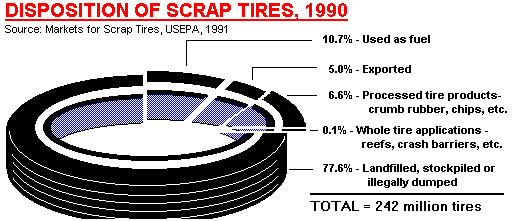
 | Every day, American families produce an estimated 4 million pounds of household hazardous waste (nail polish, paint thinner, batteries, etc. |
 | Fifty U.S. states dispose of toxic waste in another state. |
 | Enough hazardous waste is generated in one year in the U.S. to fill the New Orleans Superdome 1,500 times over. |
 | In 1994, 13.6 million tons of food waste ended up in the municipal solid waste stream. |
 | Americans throw away 570 diapers per second - thats 49 million diapers a year. |
 | If you stacked all the refrigerators Americans buy in a single week, you'd have a tower more than 80 miles high. |
 | Durable goods, such as refrigerators and television sets, made up 16% of the 1994 U.S. municipal solid waste stream by weight, or 25.5 million tons of waste. |
 | Nondurable goods made up 27.6% of the 1994 U.S. municipal solid waste stream by weight, or 44.1 million tons of waste. |
 | 10% of the average grocery bill pays for packaging - that's more than goes to the farmers. |
 | One-third of all garbage discarded by Americans is packaging. |
 | An American discards an average of 100 styrofoam cups per year. |
 | Used computer printer laser cartridges can be refilled or recycled. Empty toner cartridges can be mailed free to their maker if shipped via UPS or Mailboxes, Etc. For more information, call Cannon at 800-962-2708m Hewlett-Packard at 800-527-3753, or Apple at 800-776-2333. |
 | Refrigerators, freezers, and air conditioners contain chlorofluorocarbons (CFCs) that must be reclaimed prior to disposal or recycling. |
 | The Kidney Foundation will accept donated old cars and arrange for pick-up. The money goes to treat kidney illness. Call 1-800-382-9971 for more information. |
 | To learn of the nearest collection site that accepts plastic "peanuts" used as fill in packaging, call the "Peanut Pipeline", a 24-hour toll-free hotline set-up by the Plastic Loose Fill Council, at 1-800-828-2214. |
 | For information on expanded polystyrene (EPS) foam recycling, call the Association of Foam Packaging Recyclers at 800-944-8448. |
This page: (C) Copyright, 1996 by Purdue Research Foundation, West Lafayette, Indiana 47907. All Rights Reserved
Ways to save money AND help the environment:
Eat healthier AND save money: Instant Pot Duo Crisp 11-in-1 Air Fryer and Electric Pressure Cooker Combo with Multicooker Lids that Fries, Steams, Slow Cooks, Sautés, Dehydrates
Save water AND money with this showerhead adapter, it lets the water flow until the water is hot, then shuts off water flow until you restart it, ShowerStart TSV Hot Water Standby Adapter
Protect your health with these:
Mattress Dust mite-Bedbug protector, 100% Waterproof, Hypoallergenic, Zippered
Handheld Allergen Vacuum Cleaner with UV Sanitizing and Heating for Allergies and Pet, Kills Mite, Virus, Molds, True HEPA with Powerful Suction removes Hair, Dander, Pollen, Dust,
Immune Support Supplement with Quercetin, Vitamin C, Zinc, Vitamin D3
GermGuardian Air Purifier with UV-C Light and HEPA 13 Filter, Removes 99.97% of Pollutants
5 Stage Air Purifier, Features Ultraviolet Light (UVC), H13 True Hepa, Carbon, PCO, Smart Wifi, Auto Mode, Quiet, Removes 99.97% of Particles, Smoke, Mold, Pet Dander, Dust, Odors
Interesting Reads:
THE PREPPER'S CANNING & PRESERVING BIBLE: [13 in 1] Your Path to Food Self-Sufficiency. Canning, Dehydrating, Fermenting, Pickling & More, Plus The Food Preservation Calendar for a Sustainable Pantry
The Backyard Homestead: Produce all the food you need on just a quarter acre! Paperback
The Citizens' Guide to Geologic Hazards: A Guide to Understanding Geologic Hazards Including Asbestos, Radon, Swelling Soils, Earthquakes, Volcanoes
The Uninhabitable Earth: Life After Warming
Book: The Sixth Extinction: An Unnatural History Paperback